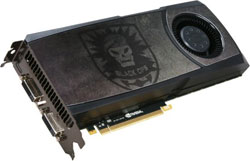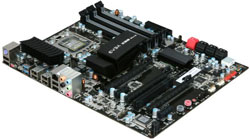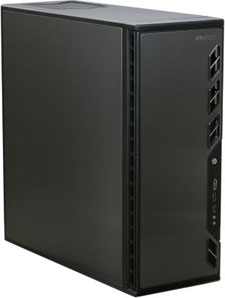Holiday 2010 System Builder's Guide
by AnandTech Staff, edited by Jarred Walton on November 19, 2010 2:00 AM EST- Posted in
- Guides
- Systems
- Holiday 2010
| Ryan's High-End Gaming System | ||
| Hardware | Component | Price |
| Processor |
Intel Core i7-950 Bloomfield 45nm (Quad-core + HTT, 3.06 to 3.33 GHz, 8MB L3, 130W) |
$295 |
| Motherboard | EVGA X58 SLI3 (Intel X58+ICH10R, LGA1366) | $210 |
| Video | EVGA GeForce GTX 580 1.5GB | $510 |
| Alt. Video | Sapphire Radeon HD 5970 2GB | $460 |
| Memory |
Corsair XMS3 6GB (3x2GB) DDR3 1600 (TR3X6G1600C9) |
$120 |
| Hard Drive | Western Digital Caviar Black 1.5TB (WD1501FASS) | $120 |
| SSD | OCZ Vertex 2 120GB (-$30 MIR) | $205 |
| Optical Drive | LG 22X DVDRW (GH22LS50) | $17 |
| Sound Card | Creative SoundBlaster X-Fi Titanium | $80 |
| Case | Antec P183 Black Aluminum | $155 |
| HSF | Tuniq Tower 120 Extreme | $65 |
| Power Supply | Antec TPQ-850 (850W) | $150 |
| Monitor | HP ZR24W (24" 1920x1200, S-IPS) | $400 |
| Alt. Monitor | ASUS VG236H w/3D Kit (23" 1920x1080 TN, 120Hz) | $475 |
| Total System Price (Range based on GPU and LCD choice) | $2277-$2402 | |
Although PC gaming can actually be quite cheap these days (see our midrange systems from Jarred and Vivek), for the hardcore among us a system built with a GTX 460/6850 class video card isn't going to cut it when it comes getting the most out of the PC's graphical advantage. For that you need to turn to something faster, better, more expandable, and ideally not much louder. To accomplish this goal I went to work on piecing together a system for around $2000 that should be able to tackle everything short of Crysis on Enthusiast settings.

The centerpiece of the system is one of NVIDIA's new GeForce GTX 580s, which currently holds the mantle as the fastest single-GPU card on the market. Being NVIDIA's highest-end video card the GTX 580 is by far the most expensive component in our system, but it does a great job of mixing performance, image quality (transparency AA), and reasonable amounts of noise. As all the GTX 580s on the market are reference cards, the choice comes down to the manufacturer and whether you want a factory overclocked model or not; in this case I went with EVGA based on availability, their overclocking tools, and their lifetime warranty.
An alternative here is the Radeon HD 5970, which ends up being cheaper. The performance is actually better than the GTX 580 so long as we're not VRAM limited, but the dual-GPU card means we give up some flexibility as 4-way CF scaling is limited at best, and the 5970 is a louder card than the GTX 580. However this option is a better choice if you want to take advantage of AMD's Eyefinity system in combination with 3 cheap 1080P TN monitors.
With our GTX 580 in hand we want to pair it with a fast processor and an SLI-capable motherboard to leave future expansion on the table. For this I'm going with an X58 board, specifically EVGA's X58 SLI3 as it offers strong overclocking abilities and is one of the cheapest SLI capable X58 boards on the market. EVGA has also equipped it with third-party USB3.0 and SATA 6Gbps controllers, giving the board plenty of capability in the future with new generation USB and SATA devices.

For the processor I chose Intel's cheapest X58 Core i7, the Core i7 950. At 3.06GHz base and a 3.33GHz Turbo mode it's already fairly fast, but at this stage in the game Bloomfield overclocking is dead simple. Combined with the massive Tuniq Tower 120 Extreme cooler, there's a very good chance of hitting 4GHz (or more!) on the 950, which should be plenty for even the most stubborn single-threaded game. Just be sure to install the Tuniq Tower on the motherboard before installing the motherboard in the case.
Since this is primarily an overclocked gaming system, I selected Corsair's XMS3 6GB triple-channel DDR3 1600 kit. The CAS9 latency at DDR3 1600 speeds is nothing to write home about, but gaming is rarely latency sensitive and the high speeds of the RAM will be very helpful for overclocking. 12GB is also an option here at a higher price, but at the moment only a couple of games are capable of using more than 2GB/4GB of RAM since few games come with a 64-bit executable.
As for storage, a high-end system deserves flexibility and speed, so I used both an SSD and a traditional hard drive; unfortunately, the size of modern games makes an all-SSD setup impractical. There are a number of fast SDDs on the market, and while you don't necessarily need something that's great at random reads and writes OCZ's SandForce-1200 based Vertex 2 120GB is no slouch at that or at sustained reads and writes; if nothing else it will keep Windows very responsive. Furthermore at 120GB it's big enough for at least a few games, making it perfect for MMOs and their need to aggressively pre-cache and log everything. For more traditional games that don't hit up local storage between levels, the 1.5TB Western Digital Caviar Black is plenty fast and big enough to hold more games than most people could possibly play at once.
Rounding things out I decided to go with a discrete sound card rather than relying on onboard sound. Creative's X-Fi line is still the premiere line of soundcards for gaming, as they bring the audio quality benefits of a discrete sound card with support for OpenAL for modern games and support for EAX for older games. As for external storage just about any DVD burner will do; I'm using a 22X Samsung but there are a number of alternatives. Blu-ray readers are coming down in price, but at this point there's no momentum to distribute games for PCs on Blu-ray discs.

Housing all of this will be Antec's P183, the latest in Antec's noise-optimized P18x series of cases. Ideally we don't want to make any compromises, and a fast system doesn't need to be noisy. Along with the quieter GTX 580 and the Tuniq Tower 120, the Antec P183 is the third and final piece of the puzzle. The triple-layer panels will deaden what sound comes from the CPU and GPU coolers, and the 120mm fans will provide enough airflow to keep things cool. As a mid-tower case it's not particularly huge so I'd suggest removing the upper hard drive bay to give the video card(s) extra room, and consider a 120mm fan mounted behind that if you ever expand to two cards. Antec does build the bigger P193, but this shouldn't be necessary with external exhaust cards like the GTX 580.
In order to power our existing system and to have enough extra power for SLI in the future you'll need a fairly strong PSU, and the Antec TPQ-850 is exactly that; it's also the 850W version of the PSU we use in our GPU test bed. The TPQ-850 balances our power needs against the P183's longer cable requirements (since the PSU is bottom-mounted), and the half-modular cable system means there's no need to clutter the case with extra cables unless they become necessary.
Finally, in a break from most of the other systems, I'm also going to throw in a monitor with this collection. It's my belief that a good monitor should outlast the rest of the system, so it's better to buy something good now rather than something cheap now and something still-cheap later. While this is a high-end system, 30" monitors are in a price category of their own so that leaves us with 24" LCDs. Our choice here is HP's ZR24W, a 24" 1920x1200 S-IPS monitor. It has fast pixel response times that are good for gaming without needing to compromise on the color palate or color accuracy at an angle. However since our default card here is an NVIDIA card, 3D Vision is also an option; if that piques your interest we'd go with ASUS' top of the line VG236H, which is a 23" 120Hz TN panel. The overall image quality isn't as good as the ZR24W, but a 120Hz monitor can be worth it if you like 3D Vision, or just like the 120Hz experience in general. The VG236H also includes an NVIDIA 3D Vision kit, so it won't be necessary to buy that separately.
My high-end gaming build ultimately comes out to just shy of $2000 without the monitor, or $2400-$2500 with it. Peripherals should add another $50-$200 depending on whether you're going to buy anything on top of the mouse and keyboard, such as gamepads, steering wheels, and joysticks.










112 Comments
View All Comments
prdola0 - Friday, November 19, 2010 - link
In some of the systems, I would buy a GTX460 1GB instead of the HD6850 simply because most people play in 1920x1200 and lower (I would say 1680x1050 as the most common) and in those resolutions the GTX460 is better than the HD6850. It would be also a choice for the next generation of games, if the consoles ever let it come. Otherwise very nice systems.One question though, are all those memories you guys used from QVLs of the motherboards or do you just trust them?
Thanks a lot,
Prdola
ganeshts - Friday, November 19, 2010 - link
The components suggested in my mid-range HTPC build are all tried and tested together :)therealnickdanger - Friday, November 19, 2010 - link
It would be cool if each of these builds was benched and the results were shown... :) I know that's asking a lot, but like Brian said:"Heck, there's no reason you can't at least ask for the absolute best..."
AnnihilatorX - Saturday, November 20, 2010 - link
I'd personally go for HD6850. It runs cooler, uses less power, can double up as high quality sound card (if you have a AV receiver with HDMI, Radeon HD68xx support DTS Master HD, etc).prdola0 - Monday, November 22, 2010 - link
The GTX460 can of course also double up as a high quality soind card. Why wouldn't it?blotto5 - Saturday, November 20, 2010 - link
for 1680x1050 it does perform better, but not by much. for 1920x1200 there is almost no difference, and for any resolution higher than that the 6850 blows it out of the water. when your have an amd processor and an amd chipset it would make sense to stay on the same platform and get an amd video card, everything plays nice together that way.prdola0 - Monday, November 22, 2010 - link
Any nVidia graphics card will work just as good on an AMD system as on an Intel system. How did you find that it wouldn't? That's totally false.And your statement about no difference in 1920x1200 is only valid for the GTX460 768MB. The 1GB version is actually still better at 1920x1200. According to Steam Survey, 74.2% of players play at 1680x1050 or lower resolution and only 4.19% play at higher resolutions than 1920x1200. I still don't understand why all the reviews focus so much on the 2560x1600 resolution. I wish Ryan didn't ignore that fact in his Final Words. But world isn't perfect :)
Quizzical - Friday, November 19, 2010 - link
If Zambezi isn't going to fit Socket AM3, then someone ought to tell AMD.End of page 5 of the AMD codename decoder that they released on financial analyst day:
“Zambezi”
Market: Desktop
What is it? four-, six-, or eight-core 32-nm AM3 socket desktop processor based on
the “Bulldozer” processor architecture for the enthusiast market.
Planned for introduction: 1H 2011
If I give a link, this site apparently flags the comment as spam and disallows it. But you can find it yourself as follows. Do a Google search for "AMD 2010 Financial Analyst Day". Click the (currently) top search result, to a page on AMD's site with that headline. Click the "AMD Codename Decoder" link from that page. The above is a copy and paste from the end of the document.
Dustin Sklavos - Friday, November 19, 2010 - link
Later on in the year they did say they tried to make Bulldozer compatible with the existing AM3 socket but couldn't do it, as a result you get AM3r2, where the motherboards will be backwards compatible with old AM3 chips, but the Bulldozer chips aren't going to be compatible with old AM3 boards.Quizzical - Friday, November 19, 2010 - link
The information I quoted was released by AMD last week. "Later on in the year" than that would have to be very, very recent. As I said, if the information that AMD just released is wrong, someone should tell them to fix it.